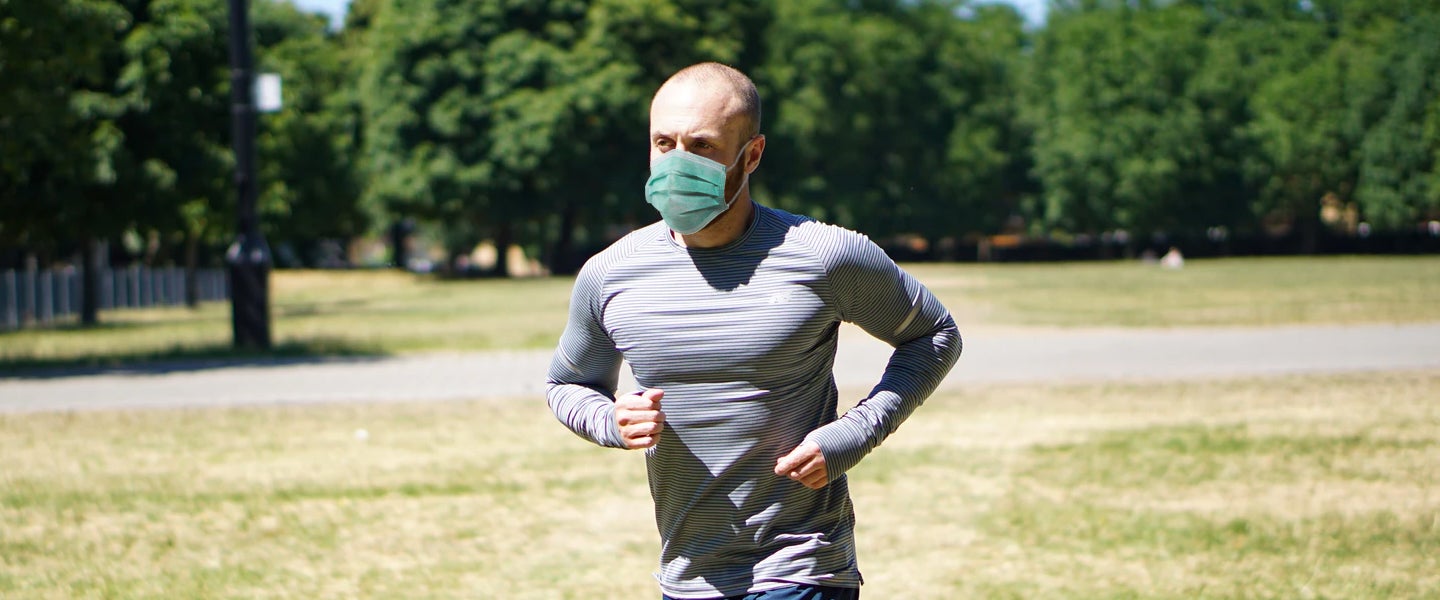Last week, the CDC recommended that everyone wear a mask at all times in public to stop the spread of the coronavirus. Some are fastening Survivor-style Buffs, bandanas and even underwear into makeshift masks. The new guidelines, however, have posed a challenge for runners.
Run Repeat reports runners who exercise once or twice a week have increased 117 percent on average. Healthy choices! The downside? With more people surging up and down sidewalks, runners are facing backlash for crowding pedestrians.
Hey sweaty ass breathing heavy ass inconsiderate ass not wearing a mask ass running on the sidewalk super close to me ass joggers…
fall back homies.
— Dean Grenier (@grenier) April 6, 2020
I don’t know who needs to hear this—EVERY RUNNER IN AMERICA—but it is your responsibility to give a way wider detour around any pedestrian than six feet as you speed past them huffing and panting.
— Clara Jeffery (@ClaraJeffery) March 31, 2020
Hey runners: that six feet thing? Yeah, it applies to you. Especially when you’re not wearing a mask.
I don’t care that you’re “fast”
Or that there isn’t much room on the sidewalk.Slow down. Wait your turn. Or run somewhere else. Or I swear to god I’ll end you.
— Christina Wallace (@cmwalla) April 6, 2020
Running and Coronavirus: Do You Need a Mask?
There is no easy way to run and practice social distancing in a crowded area. Moreover, experts are divided on whether a mask is required to minimize huffing and puffing onto passersby. The Guardian reported that the risk of a runner passing the virus to pedestrians is small, while a University of Colorado chemistry professor told Twin Cities Pioneer Press that joggers need to keep 25 feet apart.
Unsure what to do, many runners are opting to avoid crowds without wearing a mask, which may inhibit breathing over long distances of physical exertion.
Runners: are you wearing any sort of mask when you run? I am doing all kinds of swerving to avoid running near people on the streets (as all runners should) but I don’t want to risk breathing too close to someone. Thoughts?
— Carrie Resnick (@nottheverb) April 4, 2020
Paul Ronto, chief marketing officer at Run Repeat, is staying 10 to 20 feet away from people. “This is like skiing: You are the uphill skier and you should yield to those in front of you,” he tells MEL. “Sometimes you just shouldn’t pass others. If there is not enough room, just slow down and keep your distance until you have a safe passing zone.”
Given the CDC’s new guidelines, Ronto will now attempt to run with a mask. “It can’t hurt,” he says. “If you have the ability to make a few of your own out of softer materials that you can wash after every run, it’s a good idea to don one.”
If you do choose to wear a mask, the CDC recommends cloth face coverings from a bandana, T-shirt or pillowcase. Don’t go for a jog in a surgical mask or N-95 respirators.
Head Out Early — And Don’t Touch Anything
There are other measures to decrease your risk of contracting the coronavirus while running outside. “While you run, it’s inevitable you may touch your face or rub sweat from your eyes which could put you at risk,” Ronto says. So try not to touch anything like handrails, fences or crosswalk buttons. “Others may have touched those things immediately before you.”
If you can run safely, you might want to consider scheduling runs early in the morning or at night. “Running in the dark is a great way to avoid the crowds, just remember to wear reflective clothing and light so traffic can clearly see you,” Ronto says.
Joggers: If I can wear a mask on my 7-8 mile walks across town, you can wear one for your 5K practice runs
— Miles Howard (@MilesPerHoward) April 6, 2020
No matter what precautions you take, don’t stop running while you still can. France just banned outdoor daytime exercise. Exercise boosts your immune system and relieves stress — and that’s something we could all use.
So get good running shoes for your knees, break out those shorts and run far away from people. “This is a crisis that may last a lot longer than any of us anticipated,” Ronto says. “Just find a way to run responsibility without stressing out other pedestrians and remaining safe and healthy yourself.”
Stuff You Should Know About the Coronavirus
- Here’s how to clean your food while you’re protecting yourself from COVID-19.
- Dry hands? Here’s a remedy. Make sure you’re moisturizing!
- HIV-positive people who lived through the AIDS crisis are experiencing a surreal and traumatic kind of déjà vu.
- At-home COVID-19 tests are, so far, total crap.
- Delivery drivers say they’re struggling to find places to pee and wash their hands.
- Coronavirus memes reveal how shameful the American health-care system really is.
- Many young people who tested positive didn’t realize they were carriers of COVID-19 — and they’re terrified they may have passed it to more vulnerable loved ones.
- Try to de-stress. Your immune system will thank you.
- You might want to take your clothes off as soon as you step inside your house.
- Restaurants are getting creative about selling bulk booze orders.
- It’s time to sit back and listen to some Steely Dan — the perfect music for the moment.

